Report on Child and Young Person Development: Unit 331 Analysis
VerifiedAdded on 2023/01/04
|17
|4264
|59
Report
AI Summary
This report, focusing on Unit 331, provides a detailed exploration of child and young person development from birth to 19 years. It examines the sequence and rate of development across various domains, including social and emotional, physical, communication, and intellectual aspects. The report differentiates between development sequence and rate, emphasizing their importance. It also investigates the influence of personal factors such as health, disability, and learning difficulties, as well as external factors like poverty, family environment, personal choices, and education on development. Furthermore, it discusses how development theories and frameworks support current practices. The report outlines methods for monitoring development, reasons for deviations from expected patterns, and the impact of disabilities. Finally, it explores various interventions to promote positive outcomes, the importance of early identification of communication delays, and the effects of transitions on children and young people's development.
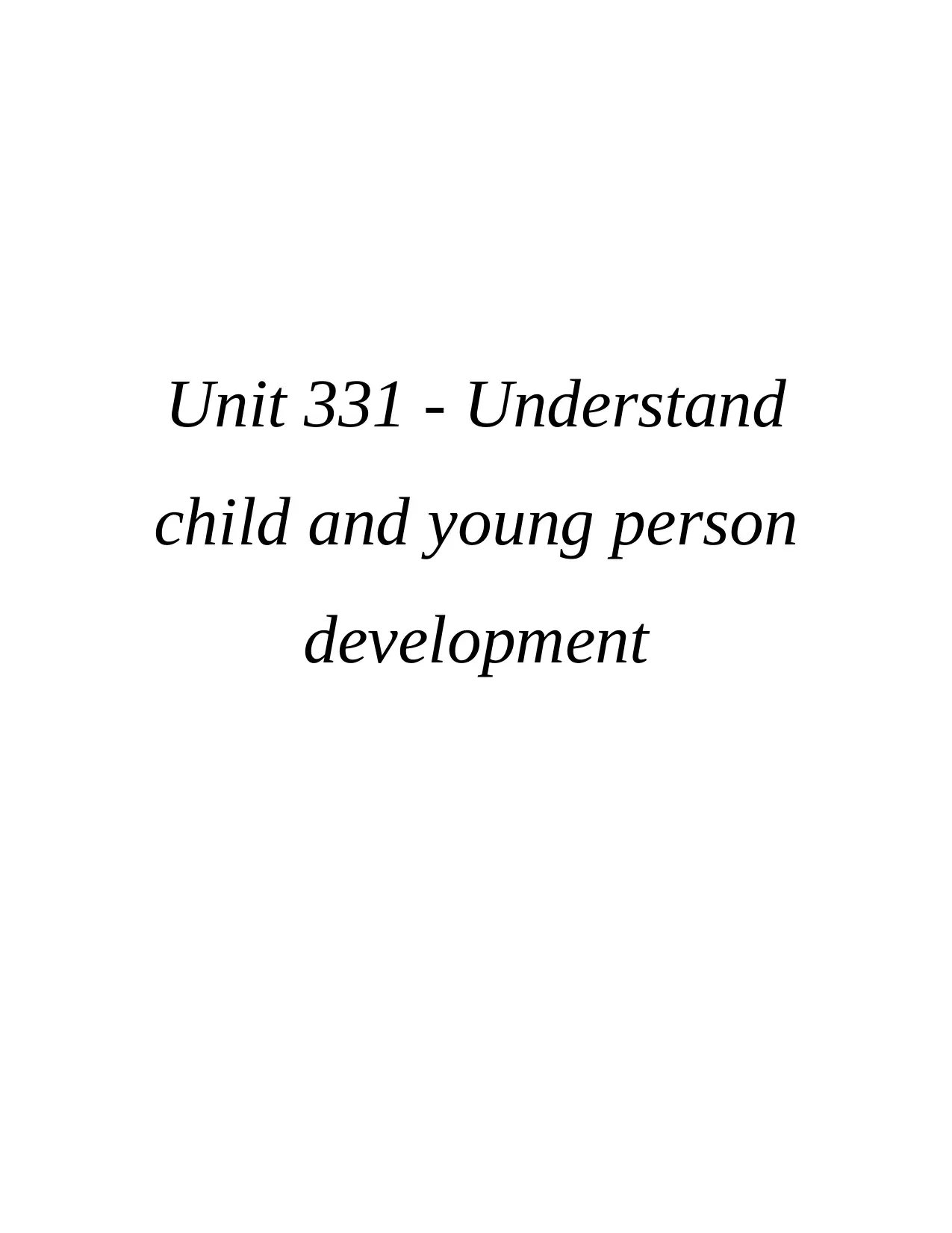
Unit 331 - Understand
child and young person
development
child and young person
development
Paraphrase This Document
Need a fresh take? Get an instant paraphrase of this document with our AI Paraphraser
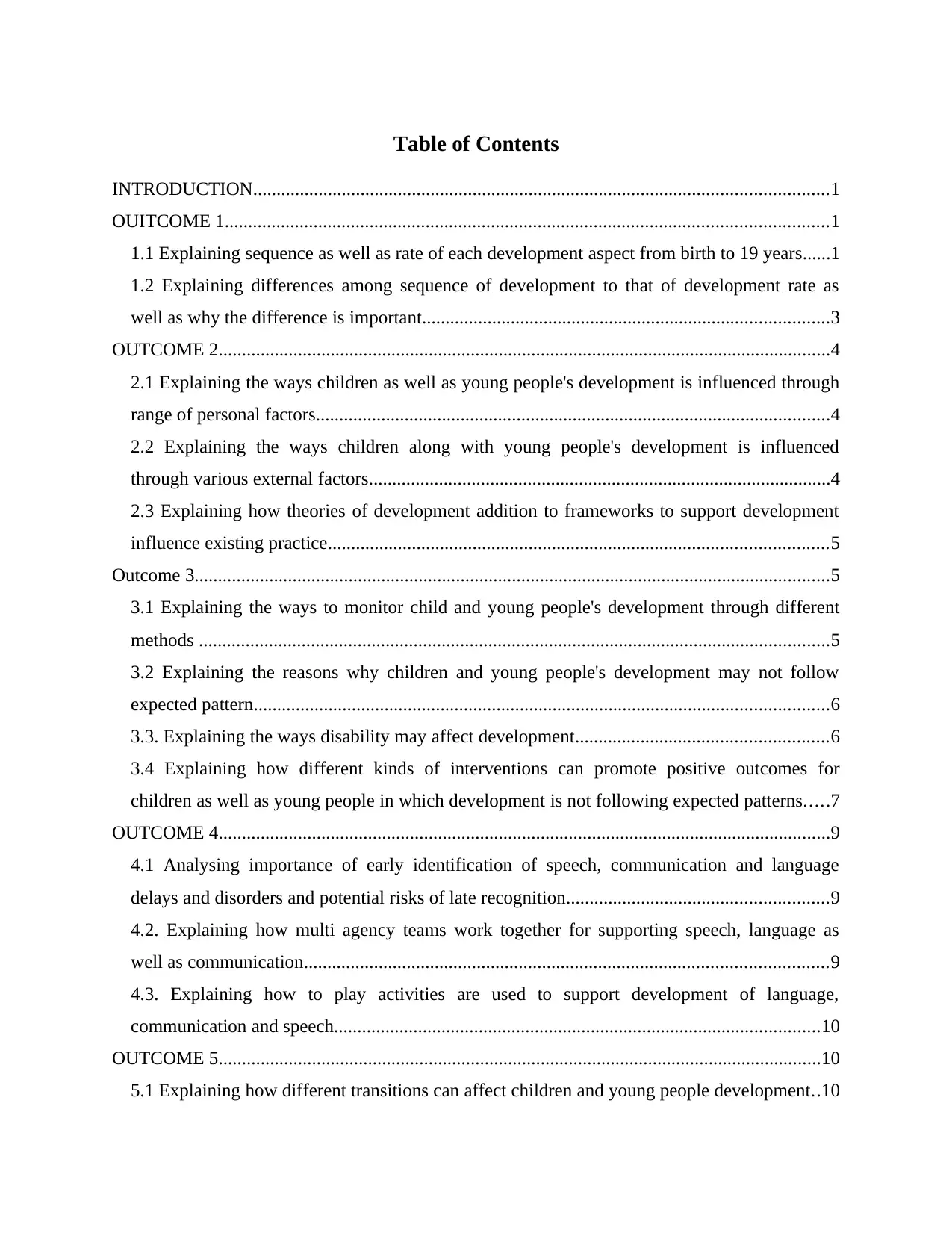
Table of Contents
INTRODUCTION...........................................................................................................................1
OUITCOME 1.................................................................................................................................1
1.1 Explaining sequence as well as rate of each development aspect from birth to 19 years......1
1.2 Explaining differences among sequence of development to that of development rate as
well as why the difference is important.......................................................................................3
OUTCOME 2...................................................................................................................................4
2.1 Explaining the ways children as well as young people's development is influenced through
range of personal factors..............................................................................................................4
2.2 Explaining the ways children along with young people's development is influenced
through various external factors...................................................................................................4
2.3 Explaining how theories of development addition to frameworks to support development
influence existing practice...........................................................................................................5
Outcome 3........................................................................................................................................5
3.1 Explaining the ways to monitor child and young people's development through different
methods .......................................................................................................................................5
3.2 Explaining the reasons why children and young people's development may not follow
expected pattern...........................................................................................................................6
3.3. Explaining the ways disability may affect development......................................................6
3.4 Explaining how different kinds of interventions can promote positive outcomes for
children as well as young people in which development is not following expected patterns.....7
OUTCOME 4...................................................................................................................................9
4.1 Analysing importance of early identification of speech, communication and language
delays and disorders and potential risks of late recognition........................................................9
4.2. Explaining how multi agency teams work together for supporting speech, language as
well as communication................................................................................................................9
4.3. Explaining how to play activities are used to support development of language,
communication and speech........................................................................................................10
OUTCOME 5.................................................................................................................................10
5.1 Explaining how different transitions can affect children and young people development..10
INTRODUCTION...........................................................................................................................1
OUITCOME 1.................................................................................................................................1
1.1 Explaining sequence as well as rate of each development aspect from birth to 19 years......1
1.2 Explaining differences among sequence of development to that of development rate as
well as why the difference is important.......................................................................................3
OUTCOME 2...................................................................................................................................4
2.1 Explaining the ways children as well as young people's development is influenced through
range of personal factors..............................................................................................................4
2.2 Explaining the ways children along with young people's development is influenced
through various external factors...................................................................................................4
2.3 Explaining how theories of development addition to frameworks to support development
influence existing practice...........................................................................................................5
Outcome 3........................................................................................................................................5
3.1 Explaining the ways to monitor child and young people's development through different
methods .......................................................................................................................................5
3.2 Explaining the reasons why children and young people's development may not follow
expected pattern...........................................................................................................................6
3.3. Explaining the ways disability may affect development......................................................6
3.4 Explaining how different kinds of interventions can promote positive outcomes for
children as well as young people in which development is not following expected patterns.....7
OUTCOME 4...................................................................................................................................9
4.1 Analysing importance of early identification of speech, communication and language
delays and disorders and potential risks of late recognition........................................................9
4.2. Explaining how multi agency teams work together for supporting speech, language as
well as communication................................................................................................................9
4.3. Explaining how to play activities are used to support development of language,
communication and speech........................................................................................................10
OUTCOME 5.................................................................................................................................10
5.1 Explaining how different transitions can affect children and young people development..10

5.2. Evaluating effect on children and young people of having positive relationship during
periods of transition...................................................................................................................11
CONCLUSION..............................................................................................................................12
REFERENCES..............................................................................................................................13
periods of transition...................................................................................................................11
CONCLUSION..............................................................................................................................12
REFERENCES..............................................................................................................................13
⊘ This is a preview!⊘
Do you want full access?
Subscribe today to unlock all pages.

Trusted by 1+ million students worldwide
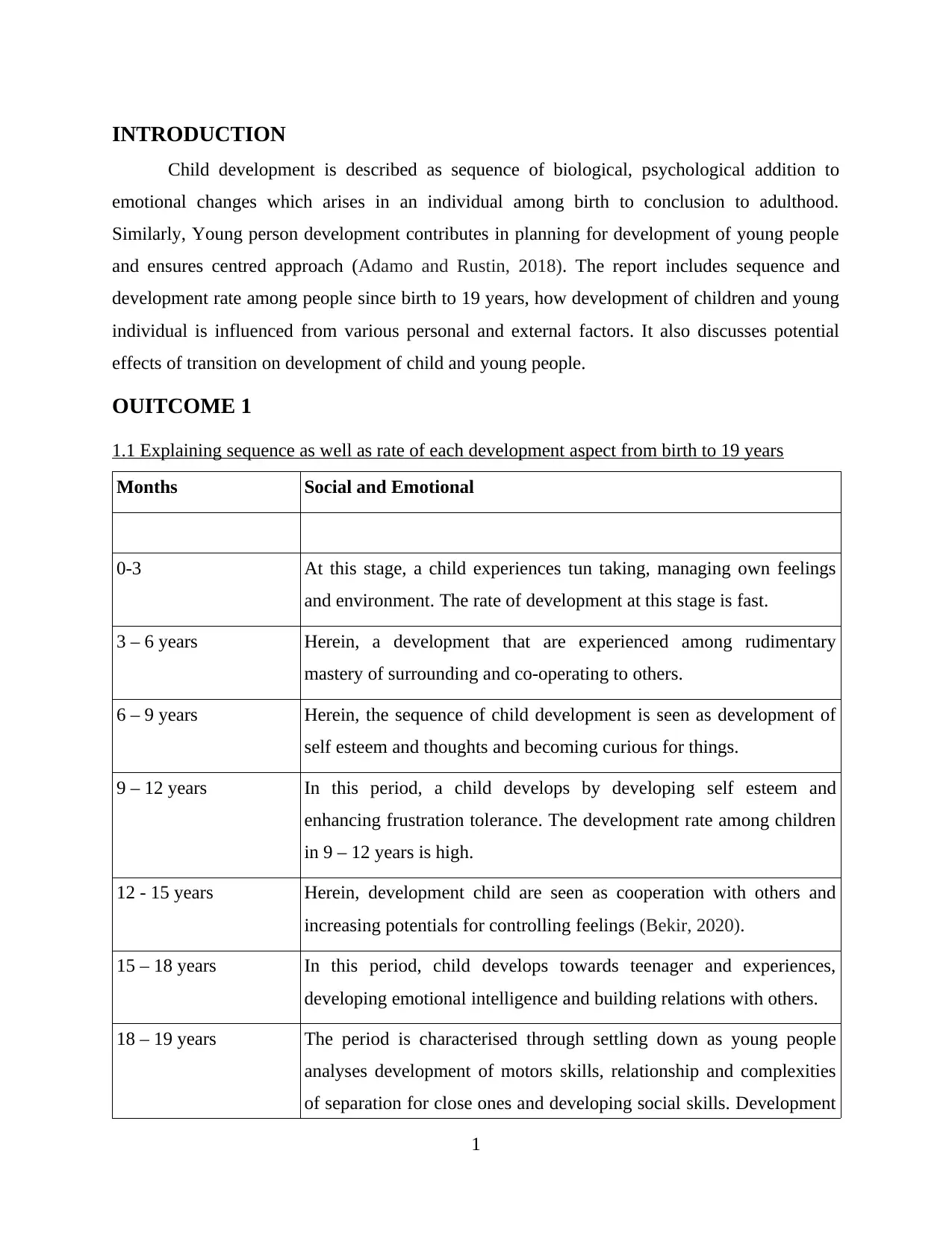
INTRODUCTION
Child development is described as sequence of biological, psychological addition to
emotional changes which arises in an individual among birth to conclusion to adulthood.
Similarly, Young person development contributes in planning for development of young people
and ensures centred approach (Adamo and Rustin, 2018). The report includes sequence and
development rate among people since birth to 19 years, how development of children and young
individual is influenced from various personal and external factors. It also discusses potential
effects of transition on development of child and young people.
OUITCOME 1
1.1 Explaining sequence as well as rate of each development aspect from birth to 19 years
Months Social and Emotional
0-3 At this stage, a child experiences tun taking, managing own feelings
and environment. The rate of development at this stage is fast.
3 – 6 years Herein, a development that are experienced among rudimentary
mastery of surrounding and co-operating to others.
6 – 9 years Herein, the sequence of child development is seen as development of
self esteem and thoughts and becoming curious for things.
9 – 12 years In this period, a child develops by developing self esteem and
enhancing frustration tolerance. The development rate among children
in 9 – 12 years is high.
12 - 15 years Herein, development child are seen as cooperation with others and
increasing potentials for controlling feelings (Bekir, 2020).
15 – 18 years In this period, child develops towards teenager and experiences,
developing emotional intelligence and building relations with others.
18 – 19 years The period is characterised through settling down as young people
analyses development of motors skills, relationship and complexities
of separation for close ones and developing social skills. Development
1
Child development is described as sequence of biological, psychological addition to
emotional changes which arises in an individual among birth to conclusion to adulthood.
Similarly, Young person development contributes in planning for development of young people
and ensures centred approach (Adamo and Rustin, 2018). The report includes sequence and
development rate among people since birth to 19 years, how development of children and young
individual is influenced from various personal and external factors. It also discusses potential
effects of transition on development of child and young people.
OUITCOME 1
1.1 Explaining sequence as well as rate of each development aspect from birth to 19 years
Months Social and Emotional
0-3 At this stage, a child experiences tun taking, managing own feelings
and environment. The rate of development at this stage is fast.
3 – 6 years Herein, a development that are experienced among rudimentary
mastery of surrounding and co-operating to others.
6 – 9 years Herein, the sequence of child development is seen as development of
self esteem and thoughts and becoming curious for things.
9 – 12 years In this period, a child develops by developing self esteem and
enhancing frustration tolerance. The development rate among children
in 9 – 12 years is high.
12 - 15 years Herein, development child are seen as cooperation with others and
increasing potentials for controlling feelings (Bekir, 2020).
15 – 18 years In this period, child develops towards teenager and experiences,
developing emotional intelligence and building relations with others.
18 – 19 years The period is characterised through settling down as young people
analyses development of motors skills, relationship and complexities
of separation for close ones and developing social skills. Development
1
Paraphrase This Document
Need a fresh take? Get an instant paraphrase of this document with our AI Paraphraser
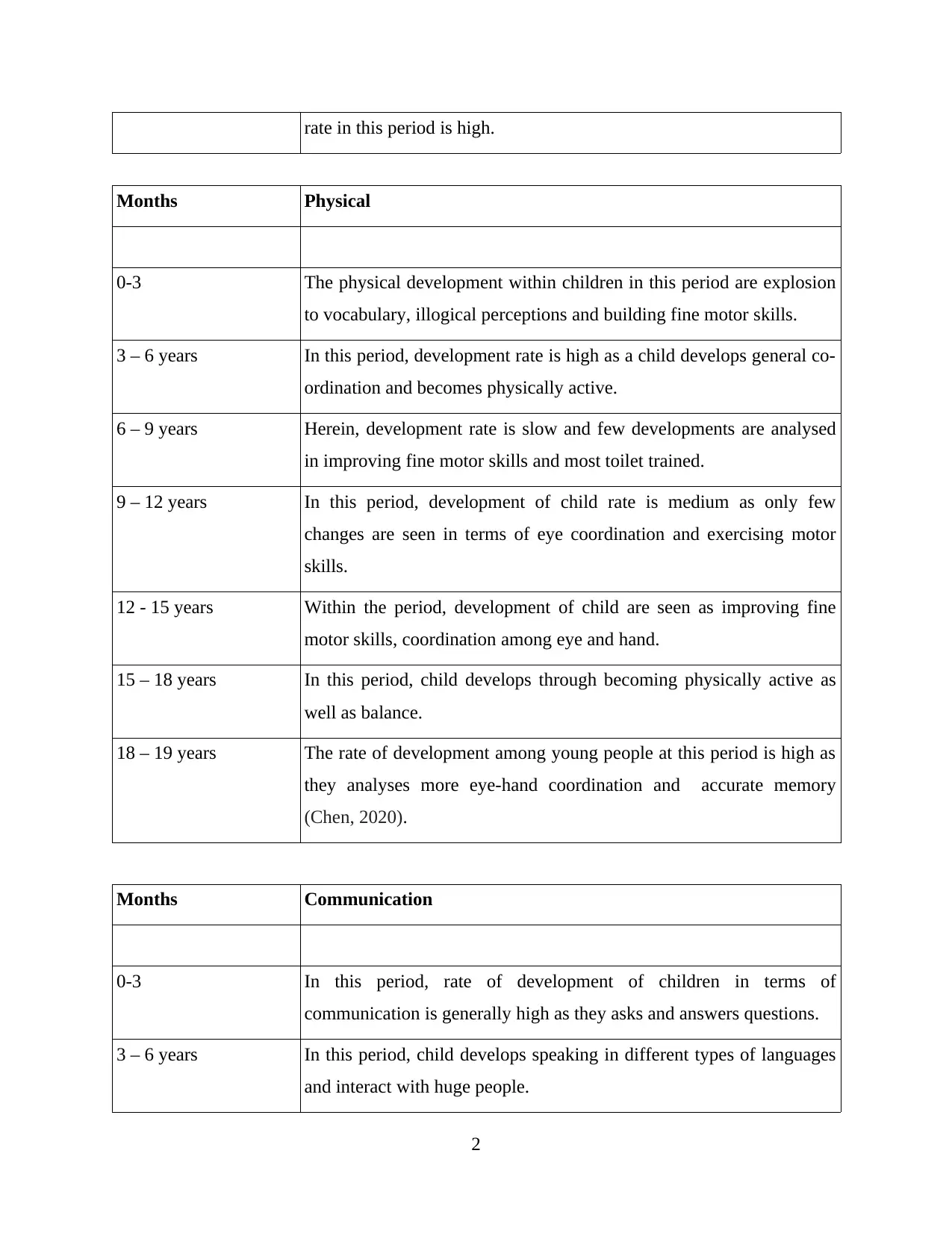
rate in this period is high.
Months Physical
0-3 The physical development within children in this period are explosion
to vocabulary, illogical perceptions and building fine motor skills.
3 – 6 years In this period, development rate is high as a child develops general co-
ordination and becomes physically active.
6 – 9 years Herein, development rate is slow and few developments are analysed
in improving fine motor skills and most toilet trained.
9 – 12 years In this period, development of child rate is medium as only few
changes are seen in terms of eye coordination and exercising motor
skills.
12 - 15 years Within the period, development of child are seen as improving fine
motor skills, coordination among eye and hand.
15 – 18 years In this period, child develops through becoming physically active as
well as balance.
18 – 19 years The rate of development among young people at this period is high as
they analyses more eye-hand coordination and accurate memory
(Chen, 2020).
Months Communication
0-3 In this period, rate of development of children in terms of
communication is generally high as they asks and answers questions.
3 – 6 years In this period, child develops speaking in different types of languages
and interact with huge people.
2
Months Physical
0-3 The physical development within children in this period are explosion
to vocabulary, illogical perceptions and building fine motor skills.
3 – 6 years In this period, development rate is high as a child develops general co-
ordination and becomes physically active.
6 – 9 years Herein, development rate is slow and few developments are analysed
in improving fine motor skills and most toilet trained.
9 – 12 years In this period, development of child rate is medium as only few
changes are seen in terms of eye coordination and exercising motor
skills.
12 - 15 years Within the period, development of child are seen as improving fine
motor skills, coordination among eye and hand.
15 – 18 years In this period, child develops through becoming physically active as
well as balance.
18 – 19 years The rate of development among young people at this period is high as
they analyses more eye-hand coordination and accurate memory
(Chen, 2020).
Months Communication
0-3 In this period, rate of development of children in terms of
communication is generally high as they asks and answers questions.
3 – 6 years In this period, child develops speaking in different types of languages
and interact with huge people.
2
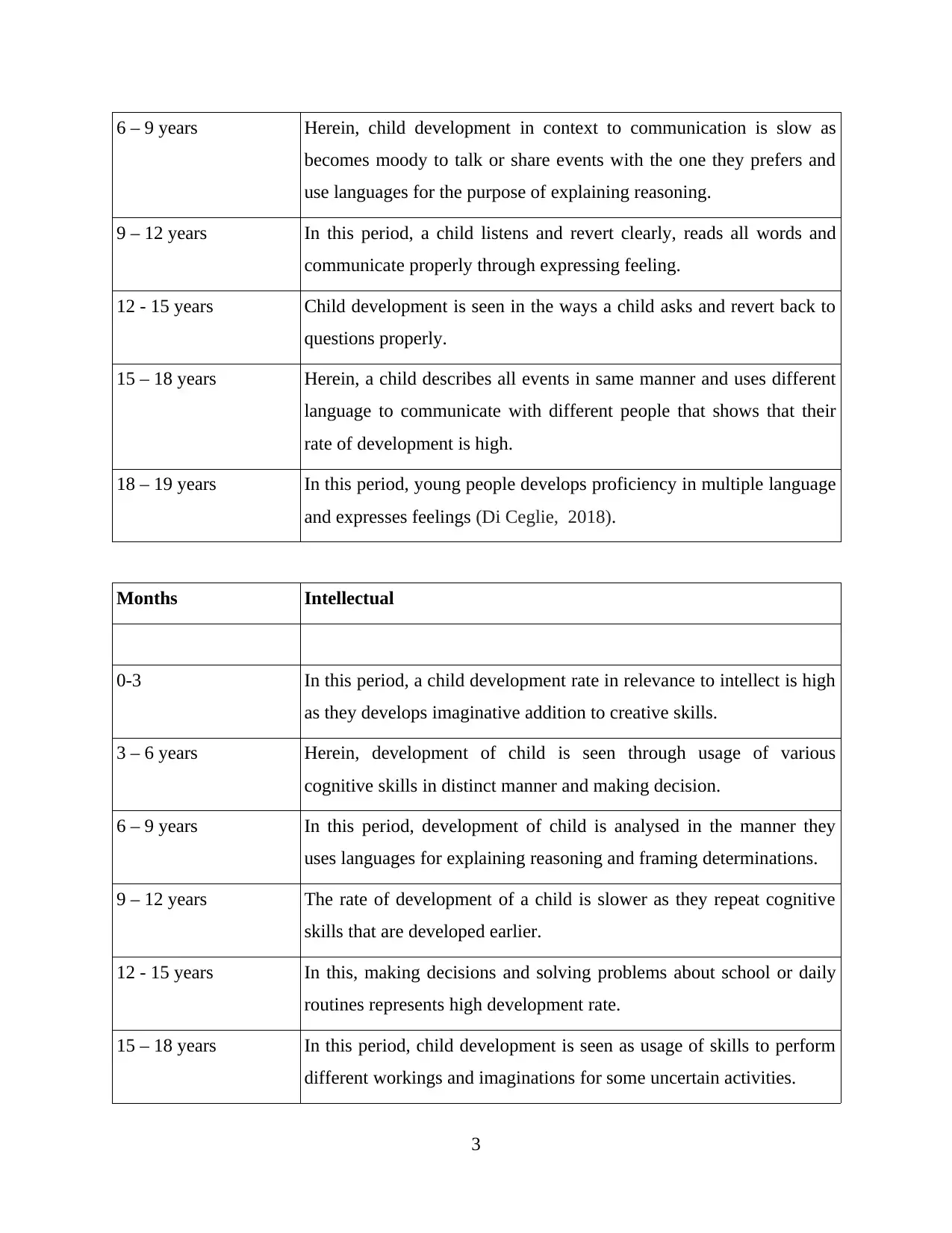
6 – 9 years Herein, child development in context to communication is slow as
becomes moody to talk or share events with the one they prefers and
use languages for the purpose of explaining reasoning.
9 – 12 years In this period, a child listens and revert clearly, reads all words and
communicate properly through expressing feeling.
12 - 15 years Child development is seen in the ways a child asks and revert back to
questions properly.
15 – 18 years Herein, a child describes all events in same manner and uses different
language to communicate with different people that shows that their
rate of development is high.
18 – 19 years In this period, young people develops proficiency in multiple language
and expresses feelings (Di Ceglie, 2018).
Months Intellectual
0-3 In this period, a child development rate in relevance to intellect is high
as they develops imaginative addition to creative skills.
3 – 6 years Herein, development of child is seen through usage of various
cognitive skills in distinct manner and making decision.
6 – 9 years In this period, development of child is analysed in the manner they
uses languages for explaining reasoning and framing determinations.
9 – 12 years The rate of development of a child is slower as they repeat cognitive
skills that are developed earlier.
12 - 15 years In this, making decisions and solving problems about school or daily
routines represents high development rate.
15 – 18 years In this period, child development is seen as usage of skills to perform
different workings and imaginations for some uncertain activities.
3
becomes moody to talk or share events with the one they prefers and
use languages for the purpose of explaining reasoning.
9 – 12 years In this period, a child listens and revert clearly, reads all words and
communicate properly through expressing feeling.
12 - 15 years Child development is seen in the ways a child asks and revert back to
questions properly.
15 – 18 years Herein, a child describes all events in same manner and uses different
language to communicate with different people that shows that their
rate of development is high.
18 – 19 years In this period, young people develops proficiency in multiple language
and expresses feelings (Di Ceglie, 2018).
Months Intellectual
0-3 In this period, a child development rate in relevance to intellect is high
as they develops imaginative addition to creative skills.
3 – 6 years Herein, development of child is seen through usage of various
cognitive skills in distinct manner and making decision.
6 – 9 years In this period, development of child is analysed in the manner they
uses languages for explaining reasoning and framing determinations.
9 – 12 years The rate of development of a child is slower as they repeat cognitive
skills that are developed earlier.
12 - 15 years In this, making decisions and solving problems about school or daily
routines represents high development rate.
15 – 18 years In this period, child development is seen as usage of skills to perform
different workings and imaginations for some uncertain activities.
3
⊘ This is a preview!⊘
Do you want full access?
Subscribe today to unlock all pages.

Trusted by 1+ million students worldwide
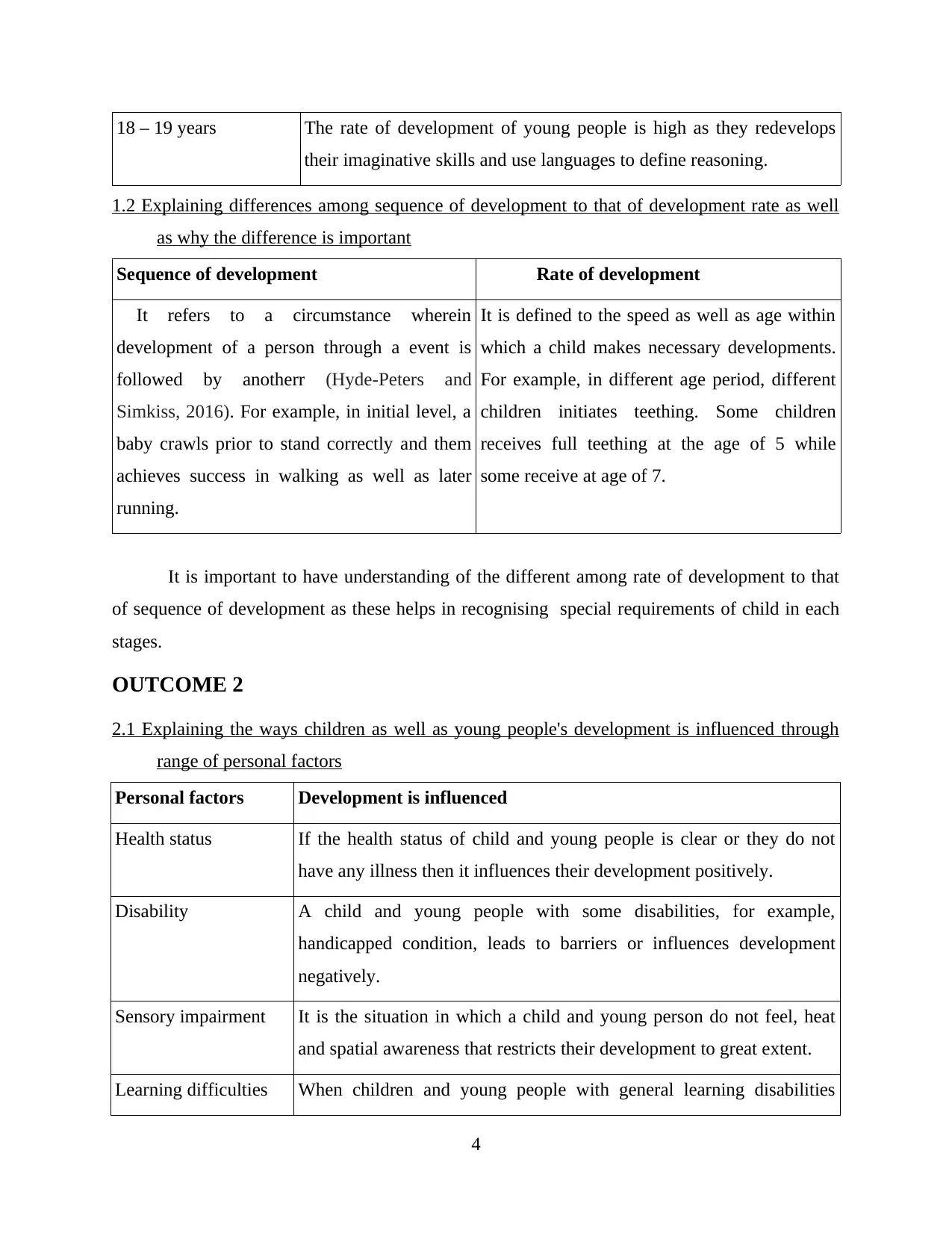
18 – 19 years The rate of development of young people is high as they redevelops
their imaginative skills and use languages to define reasoning.
1.2 Explaining differences among sequence of development to that of development rate as well
as why the difference is important
Sequence of development Rate of development
It refers to a circumstance wherein
development of a person through a event is
followed by anotherr (Hyde-Peters and
Simkiss, 2016). For example, in initial level, a
baby crawls prior to stand correctly and them
achieves success in walking as well as later
running.
It is defined to the speed as well as age within
which a child makes necessary developments.
For example, in different age period, different
children initiates teething. Some children
receives full teething at the age of 5 while
some receive at age of 7.
It is important to have understanding of the different among rate of development to that
of sequence of development as these helps in recognising special requirements of child in each
stages.
OUTCOME 2
2.1 Explaining the ways children as well as young people's development is influenced through
range of personal factors
Personal factors Development is influenced
Health status If the health status of child and young people is clear or they do not
have any illness then it influences their development positively.
Disability A child and young people with some disabilities, for example,
handicapped condition, leads to barriers or influences development
negatively.
Sensory impairment It is the situation in which a child and young person do not feel, heat
and spatial awareness that restricts their development to great extent.
Learning difficulties When children and young people with general learning disabilities
4
their imaginative skills and use languages to define reasoning.
1.2 Explaining differences among sequence of development to that of development rate as well
as why the difference is important
Sequence of development Rate of development
It refers to a circumstance wherein
development of a person through a event is
followed by anotherr (Hyde-Peters and
Simkiss, 2016). For example, in initial level, a
baby crawls prior to stand correctly and them
achieves success in walking as well as later
running.
It is defined to the speed as well as age within
which a child makes necessary developments.
For example, in different age period, different
children initiates teething. Some children
receives full teething at the age of 5 while
some receive at age of 7.
It is important to have understanding of the different among rate of development to that
of sequence of development as these helps in recognising special requirements of child in each
stages.
OUTCOME 2
2.1 Explaining the ways children as well as young people's development is influenced through
range of personal factors
Personal factors Development is influenced
Health status If the health status of child and young people is clear or they do not
have any illness then it influences their development positively.
Disability A child and young people with some disabilities, for example,
handicapped condition, leads to barriers or influences development
negatively.
Sensory impairment It is the situation in which a child and young person do not feel, heat
and spatial awareness that restricts their development to great extent.
Learning difficulties When children and young people with general learning disabilities
4
Paraphrase This Document
Need a fresh take? Get an instant paraphrase of this document with our AI Paraphraser
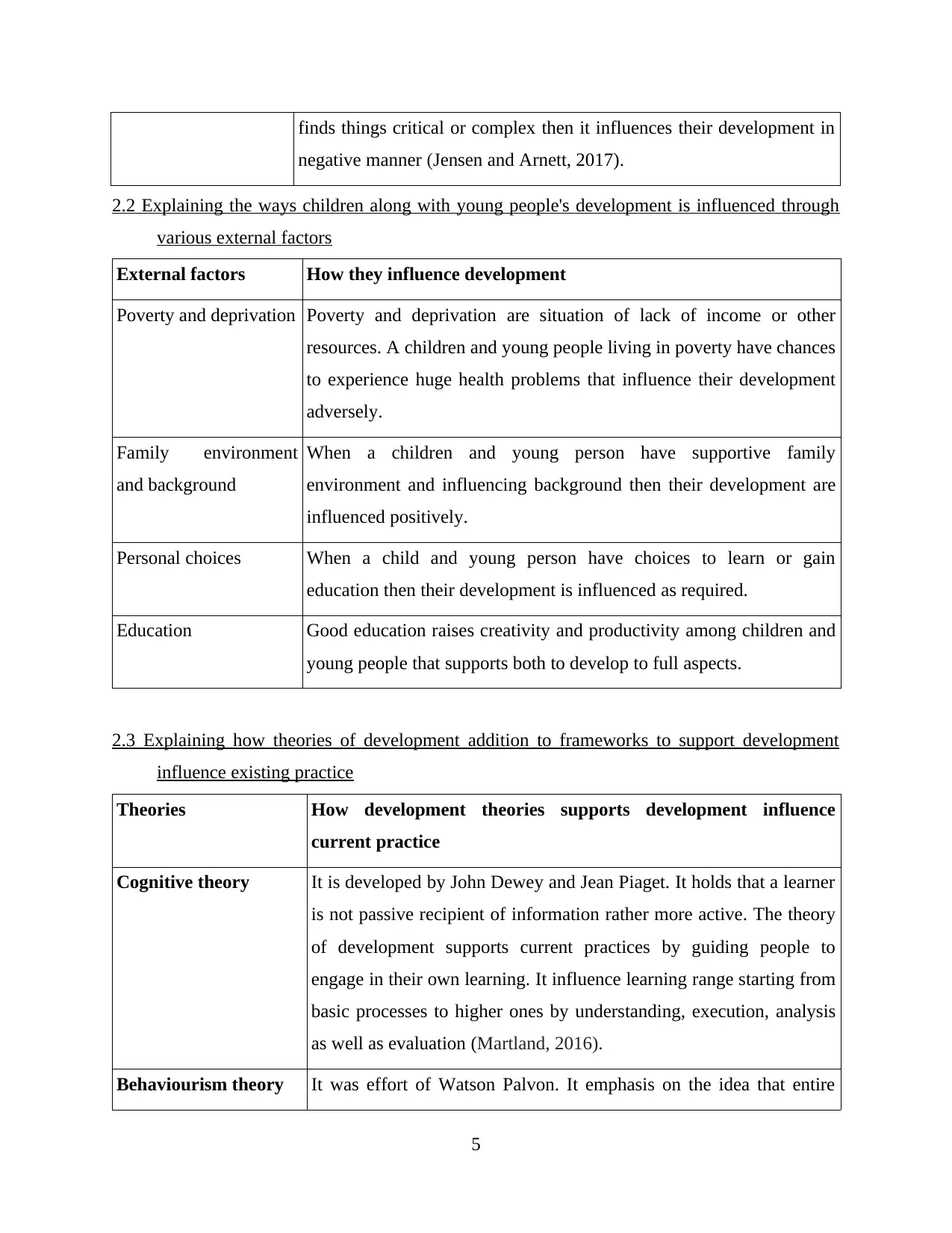
finds things critical or complex then it influences their development in
negative manner (Jensen and Arnett, 2017).
2.2 Explaining the ways children along with young people's development is influenced through
various external factors
External factors How they influence development
Poverty and deprivation Poverty and deprivation are situation of lack of income or other
resources. A children and young people living in poverty have chances
to experience huge health problems that influence their development
adversely.
Family environment
and background
When a children and young person have supportive family
environment and influencing background then their development are
influenced positively.
Personal choices When a child and young person have choices to learn or gain
education then their development is influenced as required.
Education Good education raises creativity and productivity among children and
young people that supports both to develop to full aspects.
2.3 Explaining how theories of development addition to frameworks to support development
influence existing practice
Theories How development theories supports development influence
current practice
Cognitive theory It is developed by John Dewey and Jean Piaget. It holds that a learner
is not passive recipient of information rather more active. The theory
of development supports current practices by guiding people to
engage in their own learning. It influence learning range starting from
basic processes to higher ones by understanding, execution, analysis
as well as evaluation (Martland, 2016).
Behaviourism theory It was effort of Watson Palvon. It emphasis on the idea that entire
5
negative manner (Jensen and Arnett, 2017).
2.2 Explaining the ways children along with young people's development is influenced through
various external factors
External factors How they influence development
Poverty and deprivation Poverty and deprivation are situation of lack of income or other
resources. A children and young people living in poverty have chances
to experience huge health problems that influence their development
adversely.
Family environment
and background
When a children and young person have supportive family
environment and influencing background then their development are
influenced positively.
Personal choices When a child and young person have choices to learn or gain
education then their development is influenced as required.
Education Good education raises creativity and productivity among children and
young people that supports both to develop to full aspects.
2.3 Explaining how theories of development addition to frameworks to support development
influence existing practice
Theories How development theories supports development influence
current practice
Cognitive theory It is developed by John Dewey and Jean Piaget. It holds that a learner
is not passive recipient of information rather more active. The theory
of development supports current practices by guiding people to
engage in their own learning. It influence learning range starting from
basic processes to higher ones by understanding, execution, analysis
as well as evaluation (Martland, 2016).
Behaviourism theory It was effort of Watson Palvon. It emphasis on the idea that entire
5

behaviours within a child and young people are learned from
environment involving inherited along with innate factors that
influence existing practices by reinforcements and punishments.
Outcome 3
3.1 Explaining the ways to monitor child and young people's development through different
methods
Methods Ways to monitor children and young people development
Assessment
frameworks
Assessment frameworks involves procedures for determining children
and young people who have additional requirements and multi agency
support plan which state information about necessary developments
within child and young people.
Observation Using observation, development of child and young person is analysed
through their knowledge, abilities, interests and so on for monitoring
developments.
Information for carers
and colleagues
Colleagues and carers have responsibility to monitor developments of
children and young people from multiple sources to develop an overall
picture (McKillop, 2019).
Standards
measurements
Standard measurements such as height and weight helps on monitoring
developments of children and young people as they assist in
understanding whether developments are done with ideal rate or not.
3.2 Explaining the reasons why children and young people's development may not follow
expected pattern
Reasons Explanation
Cultural Cultural factors including array of cultural differences in beliefs,
behaviours and others. Development of child and young people do not
follow cultural patterns as the grow up in different cultures in which
they receives particular inputs from pertaining environment that affects
6
environment involving inherited along with innate factors that
influence existing practices by reinforcements and punishments.
Outcome 3
3.1 Explaining the ways to monitor child and young people's development through different
methods
Methods Ways to monitor children and young people development
Assessment
frameworks
Assessment frameworks involves procedures for determining children
and young people who have additional requirements and multi agency
support plan which state information about necessary developments
within child and young people.
Observation Using observation, development of child and young person is analysed
through their knowledge, abilities, interests and so on for monitoring
developments.
Information for carers
and colleagues
Colleagues and carers have responsibility to monitor developments of
children and young people from multiple sources to develop an overall
picture (McKillop, 2019).
Standards
measurements
Standard measurements such as height and weight helps on monitoring
developments of children and young people as they assist in
understanding whether developments are done with ideal rate or not.
3.2 Explaining the reasons why children and young people's development may not follow
expected pattern
Reasons Explanation
Cultural Cultural factors including array of cultural differences in beliefs,
behaviours and others. Development of child and young people do not
follow cultural patterns as the grow up in different cultures in which
they receives particular inputs from pertaining environment that affects
6
⊘ This is a preview!⊘
Do you want full access?
Subscribe today to unlock all pages.

Trusted by 1+ million students worldwide

their development.
Social Social factors are physical surroundings, social relationships as well as
community resources that creates barriers in development of a child and
young personality that is why developments of these do not follow social
patterns.
Learning needs Learning needs pays way toward success and involves multiple
enriching activities that is why development of child and young people
do not follow expected patterns related to requirements of learning.
Communication The patterns of communication are essential for development of a child
and young person. However, ineffective communication causes huge
problems and leads to differences in required development because of
which children and young people development do not follow expected
patterns (Packer, 2017).
3.3. Explaining the ways disability may affect development
Reasons Explanation
Multiple physical
impairment
A person with multiple physical impairment faces challenges in
managing gaps among different learning and practicals that results in
affecting their developments.
Chronic disease Children or young person who have chronic disease are vulnerable and
fails to take part in development practices that affects their growth.
Mental health issues Emotional well-being of a person is important for development.
However, mental health issues restricts people to develop resilience so
to cope with the aspects which are thrown by the life.
3.4 Explaining how different kinds of interventions can promote positive outcomes for children
as well as young people in which development is not following expected patterns
Different intervention types Explanation
7
Social Social factors are physical surroundings, social relationships as well as
community resources that creates barriers in development of a child and
young personality that is why developments of these do not follow social
patterns.
Learning needs Learning needs pays way toward success and involves multiple
enriching activities that is why development of child and young people
do not follow expected patterns related to requirements of learning.
Communication The patterns of communication are essential for development of a child
and young person. However, ineffective communication causes huge
problems and leads to differences in required development because of
which children and young people development do not follow expected
patterns (Packer, 2017).
3.3. Explaining the ways disability may affect development
Reasons Explanation
Multiple physical
impairment
A person with multiple physical impairment faces challenges in
managing gaps among different learning and practicals that results in
affecting their developments.
Chronic disease Children or young person who have chronic disease are vulnerable and
fails to take part in development practices that affects their growth.
Mental health issues Emotional well-being of a person is important for development.
However, mental health issues restricts people to develop resilience so
to cope with the aspects which are thrown by the life.
3.4 Explaining how different kinds of interventions can promote positive outcomes for children
as well as young people in which development is not following expected patterns
Different intervention types Explanation
7
Paraphrase This Document
Need a fresh take? Get an instant paraphrase of this document with our AI Paraphraser
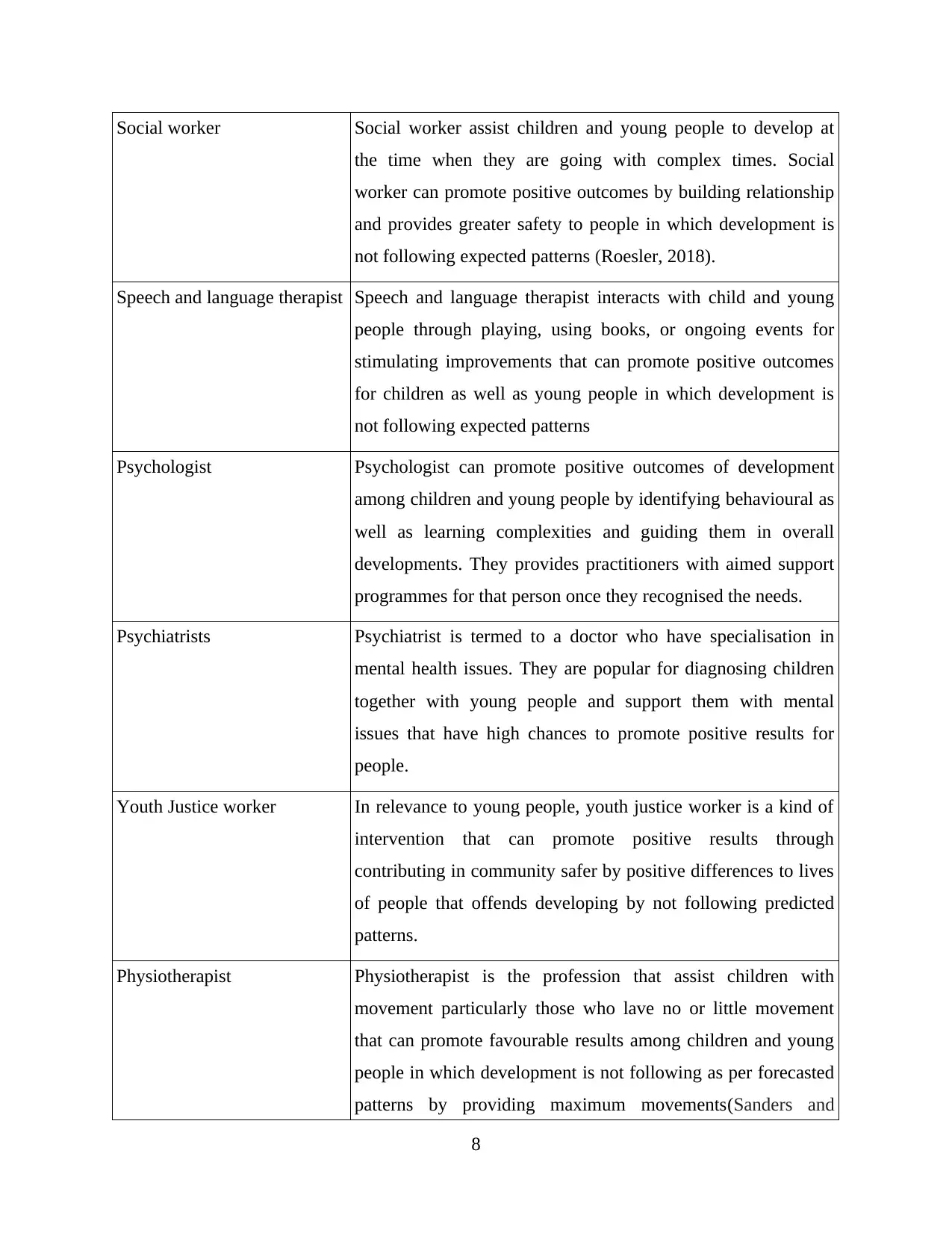
Social worker Social worker assist children and young people to develop at
the time when they are going with complex times. Social
worker can promote positive outcomes by building relationship
and provides greater safety to people in which development is
not following expected patterns (Roesler, 2018).
Speech and language therapist Speech and language therapist interacts with child and young
people through playing, using books, or ongoing events for
stimulating improvements that can promote positive outcomes
for children as well as young people in which development is
not following expected patterns
Psychologist Psychologist can promote positive outcomes of development
among children and young people by identifying behavioural as
well as learning complexities and guiding them in overall
developments. They provides practitioners with aimed support
programmes for that person once they recognised the needs.
Psychiatrists Psychiatrist is termed to a doctor who have specialisation in
mental health issues. They are popular for diagnosing children
together with young people and support them with mental
issues that have high chances to promote positive results for
people.
Youth Justice worker In relevance to young people, youth justice worker is a kind of
intervention that can promote positive results through
contributing in community safer by positive differences to lives
of people that offends developing by not following predicted
patterns.
Physiotherapist Physiotherapist is the profession that assist children with
movement particularly those who lave no or little movement
that can promote favourable results among children and young
people in which development is not following as per forecasted
patterns by providing maximum movements(Sanders and
8
the time when they are going with complex times. Social
worker can promote positive outcomes by building relationship
and provides greater safety to people in which development is
not following expected patterns (Roesler, 2018).
Speech and language therapist Speech and language therapist interacts with child and young
people through playing, using books, or ongoing events for
stimulating improvements that can promote positive outcomes
for children as well as young people in which development is
not following expected patterns
Psychologist Psychologist can promote positive outcomes of development
among children and young people by identifying behavioural as
well as learning complexities and guiding them in overall
developments. They provides practitioners with aimed support
programmes for that person once they recognised the needs.
Psychiatrists Psychiatrist is termed to a doctor who have specialisation in
mental health issues. They are popular for diagnosing children
together with young people and support them with mental
issues that have high chances to promote positive results for
people.
Youth Justice worker In relevance to young people, youth justice worker is a kind of
intervention that can promote positive results through
contributing in community safer by positive differences to lives
of people that offends developing by not following predicted
patterns.
Physiotherapist Physiotherapist is the profession that assist children with
movement particularly those who lave no or little movement
that can promote favourable results among children and young
people in which development is not following as per forecasted
patterns by providing maximum movements(Sanders and
8
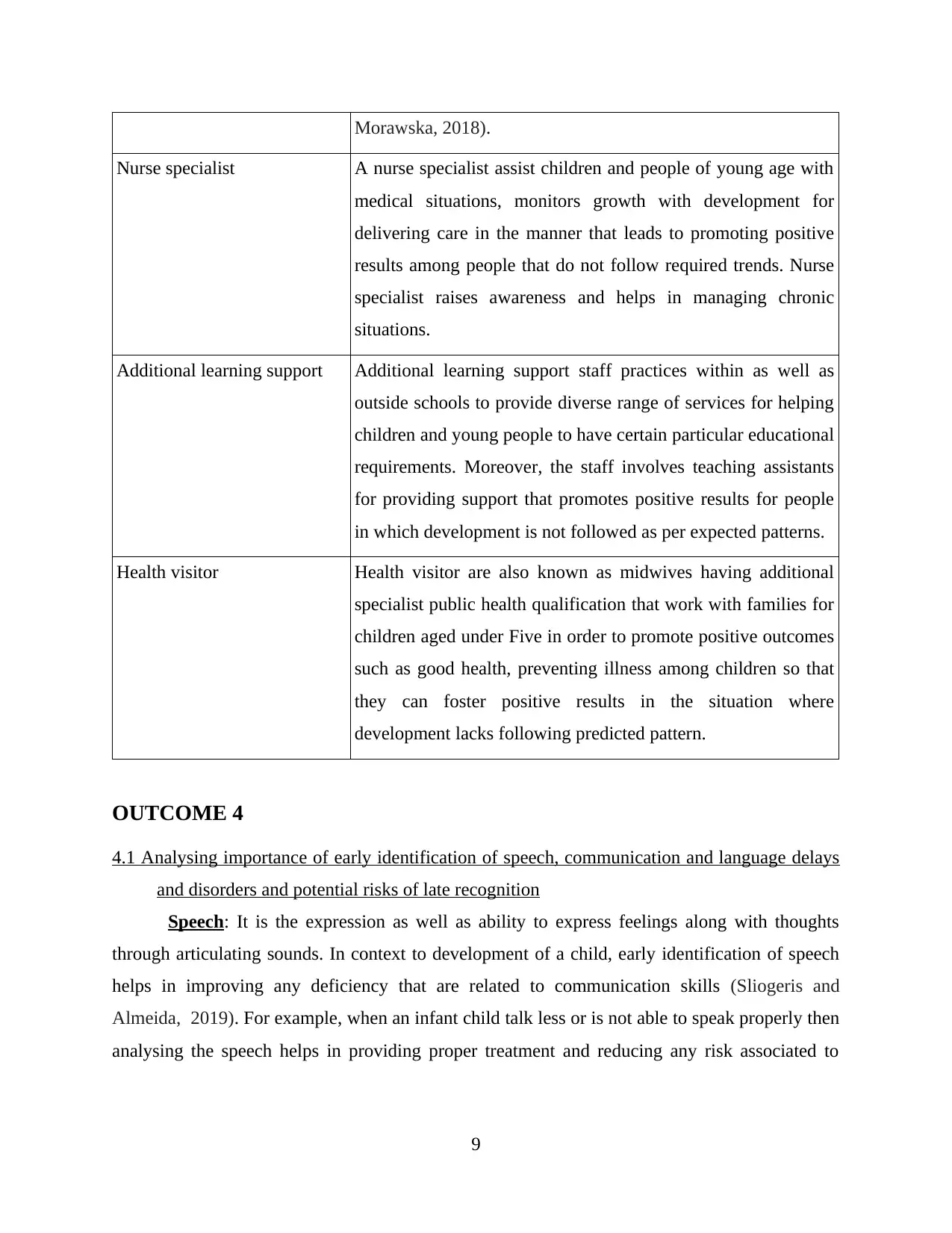
Morawska, 2018).
Nurse specialist A nurse specialist assist children and people of young age with
medical situations, monitors growth with development for
delivering care in the manner that leads to promoting positive
results among people that do not follow required trends. Nurse
specialist raises awareness and helps in managing chronic
situations.
Additional learning support Additional learning support staff practices within as well as
outside schools to provide diverse range of services for helping
children and young people to have certain particular educational
requirements. Moreover, the staff involves teaching assistants
for providing support that promotes positive results for people
in which development is not followed as per expected patterns.
Health visitor Health visitor are also known as midwives having additional
specialist public health qualification that work with families for
children aged under Five in order to promote positive outcomes
such as good health, preventing illness among children so that
they can foster positive results in the situation where
development lacks following predicted pattern.
OUTCOME 4
4.1 Analysing importance of early identification of speech, communication and language delays
and disorders and potential risks of late recognition
Speech: It is the expression as well as ability to express feelings along with thoughts
through articulating sounds. In context to development of a child, early identification of speech
helps in improving any deficiency that are related to communication skills (Sliogeris and
Almeida, 2019). For example, when an infant child talk less or is not able to speak properly then
analysing the speech helps in providing proper treatment and reducing any risk associated to
9
Nurse specialist A nurse specialist assist children and people of young age with
medical situations, monitors growth with development for
delivering care in the manner that leads to promoting positive
results among people that do not follow required trends. Nurse
specialist raises awareness and helps in managing chronic
situations.
Additional learning support Additional learning support staff practices within as well as
outside schools to provide diverse range of services for helping
children and young people to have certain particular educational
requirements. Moreover, the staff involves teaching assistants
for providing support that promotes positive results for people
in which development is not followed as per expected patterns.
Health visitor Health visitor are also known as midwives having additional
specialist public health qualification that work with families for
children aged under Five in order to promote positive outcomes
such as good health, preventing illness among children so that
they can foster positive results in the situation where
development lacks following predicted pattern.
OUTCOME 4
4.1 Analysing importance of early identification of speech, communication and language delays
and disorders and potential risks of late recognition
Speech: It is the expression as well as ability to express feelings along with thoughts
through articulating sounds. In context to development of a child, early identification of speech
helps in improving any deficiency that are related to communication skills (Sliogeris and
Almeida, 2019). For example, when an infant child talk less or is not able to speak properly then
analysing the speech helps in providing proper treatment and reducing any risk associated to
9
⊘ This is a preview!⊘
Do you want full access?
Subscribe today to unlock all pages.

Trusted by 1+ million students worldwide
1 out of 17
Related Documents
Your All-in-One AI-Powered Toolkit for Academic Success.
+13062052269
info@desklib.com
Available 24*7 on WhatsApp / Email
![[object Object]](/_next/static/media/star-bottom.7253800d.svg)
Unlock your academic potential
Copyright © 2020–2025 A2Z Services. All Rights Reserved. Developed and managed by ZUCOL.





